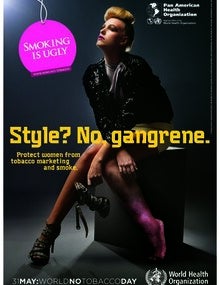World No Tobacco Day, May 31 2010: Gender and tobacco with an emphasis on marketing to women
Protect women from tobacco marketing and smoke
The tobacco industry constantly and aggressively seeks new users to replace the ones who quit and the current users - up to half - who will die prematurely from cancer, heart attack, stroke, emphysema or other tobacco-related disease.
Among the industry's many targets of opportunity, women constitute one of the biggest. That's because fewer women than men smoke or chew tobacco. Only about 9% of women smoke, compared with 40% of men. Of the world's over 1 billion smokers, only about 200 million are women.
With women, the industry simply has more room to expand.
While the epidemic of tobacco use among men is in slow decline in some countries, use among women in some countries is increasing.
The future character of the global tobacco epidemic among women can be seen in the habits of girls today. In half of the 151 countries surveyed for trends in smoking among young people, roughly as many girls smoked cigarettes as boys. In some countries, more girls smoked than boys. Teenagers who smoke are likely to become regular smokers in adulthood.
Of the over five million people who die each year from tobacco use, approximately 1.5 million are women. Unless urgent action is taken, tobacco use could kill more than eight million people by 2030, of whom 2.5 million would be women. Approximately three-quarters of these female deaths would occur in the low-income and middle-income countries that are least able to absorb such losses. Every one of these premature deaths would have been avoidable.
In some countries, the bigger threat to women is from exposure to the smoke of others, particularly men. For example, in China, where one-third of the world's adult smokers live, the tobacco epidemic is almost entirely a male phenomenon. Less than 3% of women in China smoke. Yet more than half of Chinese women of reproductive age are regularly exposed to second-hand smoke. Worldwide, of the 430,000 adult deaths caused every year by second-hand smoke, 64% occur in women.
World No Tobacco Day 2010 focuses on the harm which tobacco marketing and smoke do to women. At the same time, it seeks to make men more aware of their responsibility to avoid smoking around the women with whom they live and work.
Women, and men, must be protected from tobacco industry marketing and smoke, as stated in the preamble to the WHO Framework Convention on Tobacco Control. In effect since 2005, this international treaty acknowledges "the increase in smoking and other forms of tobacco consumption by women and young girls worldwide" and explicitly recognizes "the need for gender-specific tobacco control strategies".
Unfortunately, less than 9% of the world's population is covered by comprehensive advertising bans. Only 5.4% is covered by comprehensive national smoke-free laws.
Controlling the epidemic of tobacco among women is an important part of any tobacco control strategy. As WHO Director-General Margaret Chan has said, "Protecting and promoting the health of women is crucial to health and development - not only for the citizens of today but also for those of future generations".
Now is the time to act.
Women are at great risk
- Tobacco companies are spending heavily on alluring marketing campaigns that target women.
- Women are gaining spending power and independence. Therefore, they are more able to afford tobacco and feel freer to use it.
- Tobacco companies are investing heavily in the low-income and middle-income countries, where most potential new female users live.
- Many countries do not do enough to protect their people from second-hand smoke.
- Many women do not know about the harm done by second-hand smoke, or feel as if they have no right to complain.
The epidemic of tobacco use manifests itself differently among women
- Women's reasons for smoking often differ from men's. The tobacco industry dupes many women into believing that smoking is a sign of liberation, and many women wrongly view smoking as a good way of keeping slim.
- Women who smoke are more likely than those who do not to experience infertility and delays in conceiving. Maternal smoking during pregnancy increases the risks of premature delivery, stillbirth and newborn death and may cause a reduction in breast milk.
- Women who smoke are at increased risk of developing potentially fatal chronic obstructive pulmonary disease, which includes chronic bronchitis and emphysema.
- Smoking increases women's risks for many cancers, including cancers of the mouth, pharynx, oesophagus, larynx, bladder, pancreas, kidney and cervix, as well as for acute myeloid leukaemia. There is a possible link between active smoking and premenopausal breast cancer.
- Many tobacco control strategies ignore women who chew tobacco.
Second-hand smoke is particularly worrisome for women
- In many countries, vastly more men smoke than women, and many of those countries fail to protect nonsmokers adequately.
- In many countries, women are powerless to protect themselves, and their children, from second-hand smoke.
- In China - where one-third of the world's adult smokers live and where more than 97% of those smokers are men - more than half of women of reproductive age are regularly exposed to second-hand smoke, which puts themselves and their unborn babies at risk.
Tobacco industry marketing endangers women
- Advertisements falsely link tobacco use with female beauty, empowerment and health. In fact, addiction to tobacco enslaves and disfigures women.
- Advertisements lure women with such misleading identifiers as "light" or "low-tar". More women than men smoke "light" cigarettes, often in the mistaken belief that "light" means "safer".
Call to action
Protect women from tobacco marketing and smoke
Call to policy-makers
- Implement a comprehensive ban on all forms of tobacco advertising, promotion and sponsorship, as called for in the WHO Framework Convention on Tobacco Control.
- Implement a comprehensive ban on tobacco smoke in all public places and workplaces, likewise called for in the WHO Framework Convention.
- Heed the call in the preamble of the WHO Framework Convention for "gender-specific tobacco control strategies" and the "full participation of women at all levels of [tobacco control] policy-making and implementation [of tobacco control measures]".
- Request assistance from WHO to implement the demand-reduction provisions of the WHO Framework Convention through the MPOWER package of tobacco control measures.
- Ensure that government agencies and other stakeholders work together to take into account the different needs of men and women.
- Ensure that tobacco control strategies take into account the special problems of women who chew tobacco.
Call to civil society and nongovernmental organizations
- Advocate for full implementation of the WHO Framework Convention on Tobacco Control.
- Urge governments to take into account the specific needs of both women and men in the development of tobacco control strategies.
- Share information about the importance of controlling the global tobacco epidemic among women.
- Help to educate women about the tobacco industry's attempts to ensnare them and the dangers of tobacco use.
- Sensitize men to the harm that their second-hand smoke inflicts on the women and children with whom they live and work.
Call to the public
- Demand that your government ban all forms of tobacco advertising, promotion and sponsorship.
- Demand that your government implement legislation to provide 100% protection from tobacco smoke in all public places and workplaces.
- Campaign for women's freedom from tobacco as a human right.
KEY FACTS:
- Tobacco kills up to half of its users.
- The annual death toll of more than five million could rise to more than eight million by 2030 unless urgent action is taken to control the tobacco epidemic.
- More than 80% of the world's one billion smokers live in low- and middle-income countries.
- Total consumption of tobacco products is increasing globally, though it is decreasing in some high-income and upper middle-income countries.
Leading cause of death, illness and impoverishment
Tobacco use is one of the biggest public health threats the world has ever faced. It kills more than five million people a year - an average of one person every six seconds - and accounts for one in 10 adult deaths. Up to half of current users will eventually die of a tobacco-related disease.
More than 80% of the one billion smokers worldwide live in low- and middle-income countries, where the burden of tobacco-related illness and death is heaviest.
Tobacco users who die prematurely deprive their families of income, raise the cost of health care and hinder economic development.
In some countries, children from poor households are frequently employed in tobacco farming to provide family income. These children are especially vulnerable to "green tobacco sickness", which is caused by the nicotine that is absorbed through the skin from the handling of wet tobacco leaves.
Gradual killer:
Because there is a lag of several years between when people start using tobacco and when their health suffers, the epidemic of tobacco-related disease and death has just begun.
- Tobacco caused 100 million deaths in the 20th century. If current trends continue, it will cause up to one billion deaths in the 21st century.
- Unchecked, tobacco-related deaths will increase to more than eight million per year by 2030. More than 80% of those deaths will be in low- and middle-income countries.
Surveillance is key:
Good monitoring tracks the size and character of the epidemic and indicates how best to tailor policies. Two-thirds of countries - more than four in five of them low- and middle-income- do not have even minimal information about tobacco use.
Second-hand smoke kills:
Second-hand smoke is the smoke that fills restaurants, offices or other enclosed spaces when people burn tobacco products such as cigarettes, bidis and water pipes. There is no safe level of second-hand tobacco smoke.
Every person should be able to breathe smoke-free air. Smoke-free laws protect the health of non-smokers, are popular, do not harm business and encourage smokers to quit.1
- Only 5.4% of people are protected by comprehensive national smoke-free laws.
- In 2008, the number of people protected from second-hand smoke increased by 74% to 362 million from 208 million in 2007.
- Of the 100 most populous cities, 22 are smoke free.
- Almost half of children regularly breathe air polluted by tobacco smoke.
- Over 40% of children have at least one smoking parent.
- Second-hand smoke causes 600,000 premature deaths per year.
- In 2004, children accounted for 28% of the deaths attributable to second-hand smoke.
- There are more than 4,000 chemicals in tobacco smoke, of which at least 250 are known to be harmful and more than 50 are known to cause cancer.
- In adults,second-hand smoke causes serious cardiovascular and respiratory diseases, including coronary heart disease and lung cancer. In infants, it causes sudden death. In pregnant women, it causes low birth weight.
Tobacco users need help to quit:
Studies show that few people understand the specific health risks of tobacco use. For example, a 2009 survey in China revealed that only 37% of smokers knew that smoking causes coronary heart disease and only 17% knew that it causes stroke.2
Among smokers who are aware of the dangers of tobacco, most want to quit. Counselling and medication can more than double the chance that a smoker who tries to quit will succeed.
- National comprehensive health-care services supporting cessation are available only in 17 countries, representing 8.2% of the world's population.
- There is no cessation assistance in 29% of low-income countries and 8% of middle-income countries.
Picture warnings work:
Hard-hitting anti-tobacco advertisements and graphic pack warnings - especially those that include pictures - reduce the number of children who begin smoking and increase the number of smokers who quit.
Studies carried out after the implementation of pictorial package warnings in Brazil , Canada , Singapore and Thailand consistently show that pictorial warnings significantly increase people's awareness of the harms of tobacco use.
- Although pictures are more powerful deterrents than words on tobacco packaging warnings, only 19 countries, representing 24% of the world's population,mandate pictorial warnings.
- Just 15 countries, representing 7.6% of the world's population, meet the highest standards for pictorial warnings, which include that they be in colour and cover at least half of both the front and back of cigarette packs.
Ad bans lower consumption:
Bans on tobacco advertising, promotion and sponsorship can reduce tobacco consumption.
- Only 26 countries, representing 8.8% of the world's population, have comprehensive national bans on tobacco advertising, promotion and sponsorship.
- 27% of the world's population live in countries that do not ban free distribution of tobacco products.
Taxes discourage tobacco use:
Tobacco taxes are the most effective way to reduce tobacco use, especially among young people and poor people. A tax increase that increases tobacco prices by 10% decreases tobacco consumption by about 4% in high-income countries and by up to 8% in low- and middle-income countries.
- Only 21 countries, representing 6.2% of the world's population, have tobacco tax rates greater than 75% of the retail price.
- In countries with available information, tobacco tax revenues are 173 times higher than spending on tobacco control.
WHO Response:
WHO is committed to fight the global tobacco epidemic. The WHO Framework Convention on Tobacco Control entered into force in February 2005. Since then, it has become one of the most widely embraced treaties in the history of the United Nations with nearly 170 Parties covering 86% of the world's population. The WHO Framework Convention is WHO's most important tobacco control tool and a milestone in the promotion of public health. It is an evidence-based treaty that reaffirms the right of people to the highest standard of health, provides legal dimensions for international health cooperation and sets high standards for compliance.
In 2008, WHO introduced the MPOWER package of tobacco control measures to further counter the epidemic and to help countries to implement the WHO Framework Convention. The six MPOWER measures are:
- Monitor tobacco use and prevention policies
- Protect people from tobacco use
- Offer help to quit tobacco use
- Warn about the dangers of tobacco
- Enforce bans on tobacco advertising, promotion and sponsorship
- Raise taxes on tobacco.




